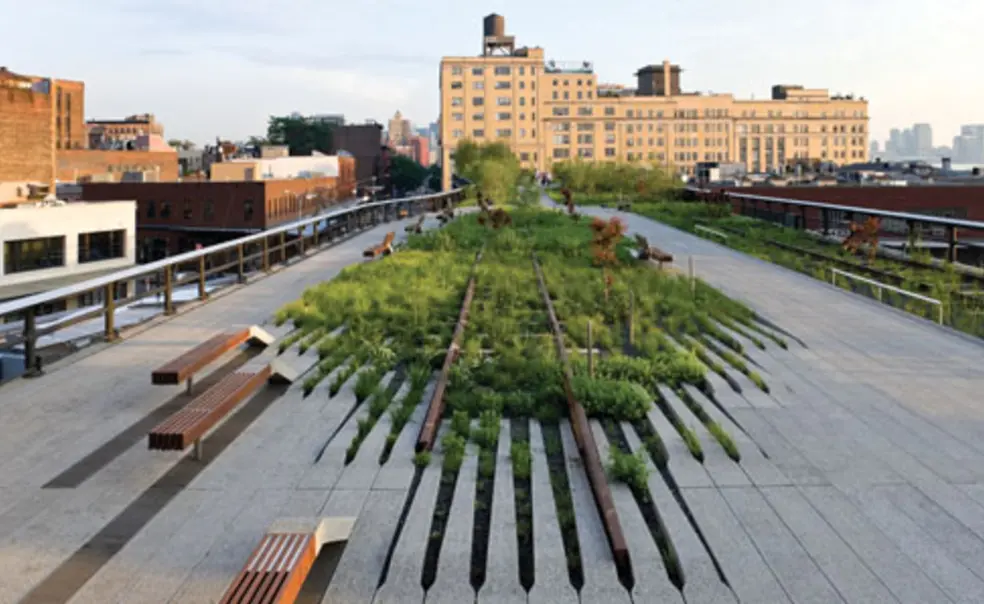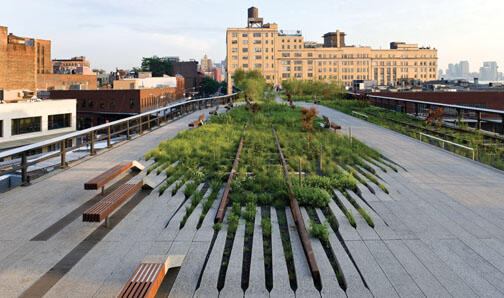
Visitors have noticed many things about the High Line, a city park that opened this summer in New York along what had been a mile and a half of abandoned elevated freight railway. Prairie grass. Berry bushes. A few old steel rails. A glass-enclosed amphitheater with a view up 10th Avenue.
More than half a million people have strolled the span — running along the Hudson River through the neighborhoods of Greenwich Village and Chelsea — since it opened in June. Some pause on a sundeck looking out over the Hudson. Others enjoy the distinctive second-story view of Manhattan.
Few visitors, though, are aware of the role that Princeton connections played in this feat of urban alchemy.
A decade ago, Robert Hammond ’92 read that the city was fighting a legal battle to demolish the old elevated freight line. Hammond, an entrepreneur and painter who lived in Greenwich Village, long had admired the rusted fragments of the steel structure overhead, so he asked the railroad’s owner for a walk along the track. “It was a mile and a half of wildflowers running right through the city, right through buildings,” he recalled. “Completely magical.”
Captivated by the idea of turning it into an aerial park, Hammond turned to old Princeton friends. “Just a really crazy, stupid idea,” was the first response from Gifford Miller ’92, then a fast-rising member of the City Council. But Hammond persuaded Miller to come see for himself — and won a pivotal ally.
Hammond’s former Princeton roommate, Mario Palumbo ’92, an executive with the real estate development company Millennium Partners, helped Hammond form a new nonprofit, Friends of the High Line, to push for the park and then run it. The group gathered critical support from other Princeton alumni: Marc A. Ricks ’96, in the mayor’s office; Kathryn Mautner Grieco ’92, a restaurant executive; Debra Singer ’89, a curator in the neighborhood; and Sukey Caceres Novogratz ’89 and her husband Michael E. Novogratz ’87, donors who financed the park’s amphitheater.
The Friends of the High Line pulled in Peter D. Mullan ’91, an architect, to oversee planning. And together with the city they hired Princeton architecture professor Elizabeth Diller and her firm Diller Scofidio + Renfro (including Matthew G. Johnson *99) to work with landscape architects James Corner Field Operations on design.
Not all of the response has been laudatory. In August, an article in The New York Times called attention to Hammond’s salary of $250,000 from the nonprofit; the group’s board said his paycheck was in line with his counterparts at other parks and arts groups.
Friends of the High Line now employs about 40 people to manage the park, which is owned by the city, in addition to about 50 volunteer “greeters” who explain it to the curious. The group has raised about $150 million for construction. A second phase, extending the park north from West 20th Street to West 30th Street, is expected to open next year. With the park open, Hammond will take a leave from November to July as a winner of the Rome Prize from the American Academy in Rome.
Each day thousands find a haven in what he helped create, reclining on the grass, picnicking with friends, or sunbathing on chaise longues overlooking the Hudson. The park’s landscape includes more than 100 species of plants, inspired by the wildflowers that were carried in from afar on rolling train wheels.
David D. Kirkpatrick ’92 is a Washington correspondent for The New York Times.
He was not involved with the paper’s coverage of Hammond or the High Line.












1 Response
Henry Posner III ’77
9 Years AgoA High Line connection
There is another Princeton connection with the High Line (Alumni Scene, Sept. 23) — namely, my service as trainmaster at 72nd Street Yard responsible for Conrail’s freight service on Manhattan’s West Side Freight Line in its final years of operation.
Recognizing that the line was on borrowed time, in 1980 I made sure that I was able to ride the line as far south as possible and accompanied a shipment of frozen food (turkeys?) to a second-story siding near 14th Street; a year or so later, service ended and the line slumbered for almost three decades, fortunately avoiding the demolition advocated by adjacent property owners.
It is gratifying to see segments of the line evolve to their best and highest uses. The south end is, of course, the High Line park. Even better, the north end is once again a functioning railroad, and a main line passenger railroad at that: Its rebuilding allowed the rerouting of Amtrak’s Albany service into Penn Station, thus allowing connections to Washington, Philadelphia, and, yes, Princeton.